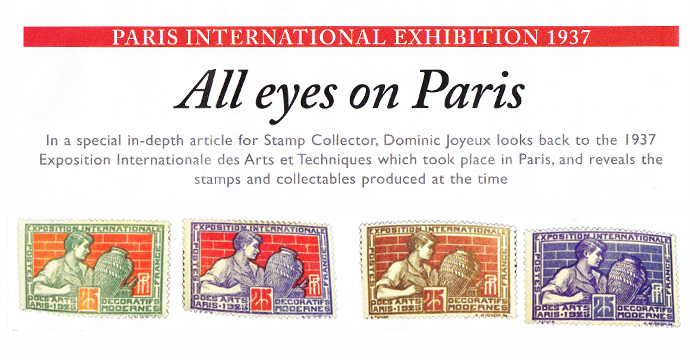
This article was published in the October 2019 edition of 'Stamp Collector'. The magazine's laid out version with pictures can be seen here.
All eyes on Paris
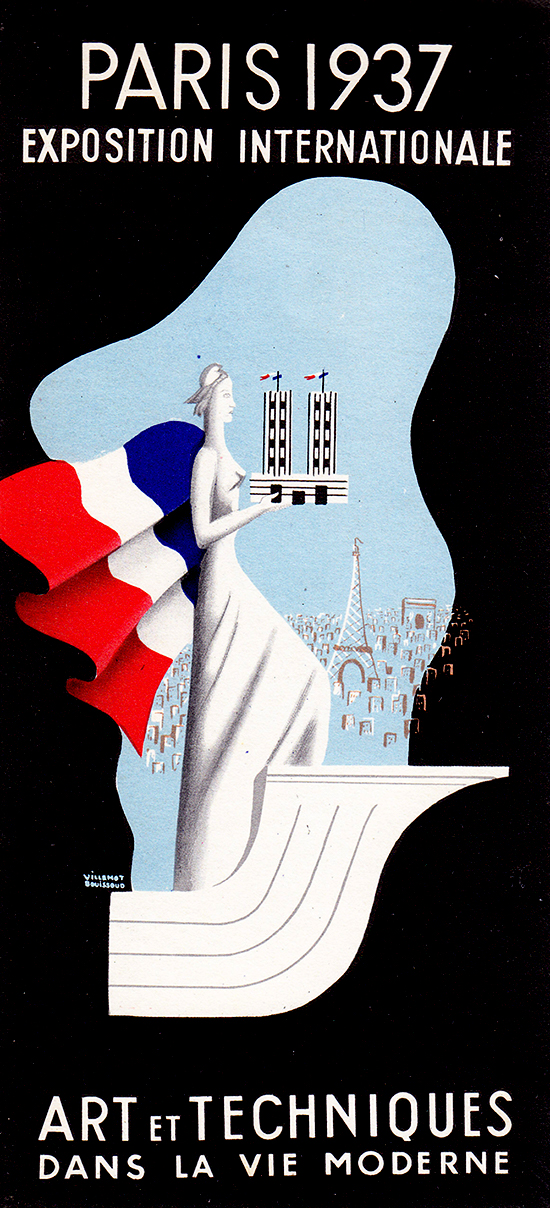
A poster from the 1937 exhibition
Eighty years' ago, political extremism was a big part of European life and this was reflected in the Paris International Exhibition of 1937. Fascism was vying with communism to win hearts and minds across the continent and France had intended to promote a peaceful unifying event.
However, the exposition had so many problems, it was to be France's sixth and last international exhibition. The postal commemorations and promotions that went alongside it fared badly too, with fakes, unissued stamps, panicked withdrawals and bad workmanship leading to the production of stamps that have become some of France's rarest.
The postal input started in January 1936, when a competition was launched to design the stamps to publicise the exhibition. The monetary prize was a derisory 5,000 francs but the prestige was considered sufficient for top designers to submit up their work for the six stamps needed.
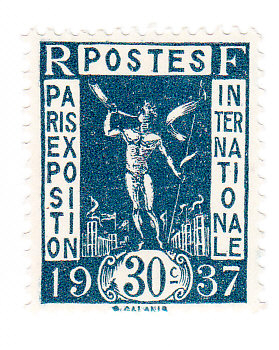
The Galanis stamp featuring the messenger god Mercury
While the new designs were being submitted, printing trials were being undertaken to see if the higher value, larger format, stamps could be produced in two colours - unusual in France before the 1950s. The 25c potter stamp, from the 1925 set celebrating the International Exhibition of Modern Decorative Arts, was chosen to try out varying combinations of colours.
In June 1936, a sheet of 75 stamps was produced for each of the four different colour essais printed using a typography process. This test seems to have worked and it is not known why the postal authorities did not proceed with the two-colour combination - the large format stamps would remain printed in monochrome. The costs involved could have had something to do with the decision, as the country was in dire financial straits at the time. Although never issued, the trial sheets did leak out and a set of four stamps can sell for a 1,000 euros online.
The four lower denomination stamps featured one design executed by Démétrius Galanis. He was a professor at l'Ecole des Beaux Arts and a designer of books. Galanis's figure ofMercury placed in front of the new Palais de Chaillot was commissioned for the four smaller format and value stamps. The 20c for internal printed matter, the 30c for foreign printed matter, the 40c for internal postcards and 50c for internal letters.
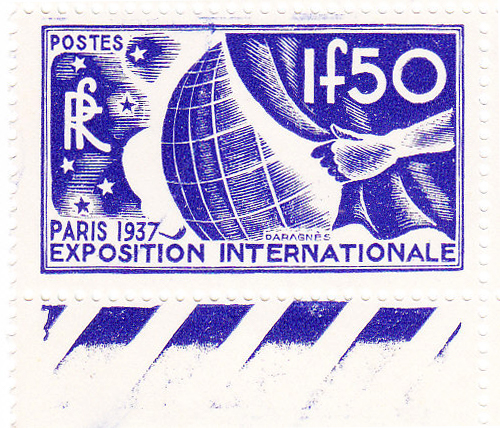
The Daragnès-design was used for both the 90c and 1Fr50c stamp.
The other successful designer was Jean-Gabriel Daragnès. He was a prolific book designer specialising in wood engravings. His design featuring a hand pulling back a curtain to reveal the world was accepted and placed on the two larger, higher value stamps - the 90c for foreign postcards and the 1f 50c for foreign letters.
Things go pear-shaped
The reception for the six stamps on 15 September 1936 was underwhelming, to say the least. Galanis' Mercury was derided as being skeletal and Deragnès' globe behind a curtain "pretentious". One headline ran "Ils ont ridiculisé l'art graphique français". Unfortunately, this wasn't the only problem coinciding with the release.
The franc was devalued by 30% at the end of that month and the Minister of the Interior was so savaged by the French press that he took his own life in October. The stamps were, in comparison, a minor problem but nevertheless it was decided to stop printing them that month.
More embarrassment was to come on 11 May 1937. The Postes, Télégraphique et Téléphones (PTT) announced the "total et immediate" withdrawal of the stamps. Two days later, the nation's newspapers told the story why. On 2 April, Aimé Brun, a philatelic expert, had asked Baron de Vinck, an important collector of coin datés and millésimes of the time, if he considered a sheet of 100 x 50c Galanis stamps to be a forgery.
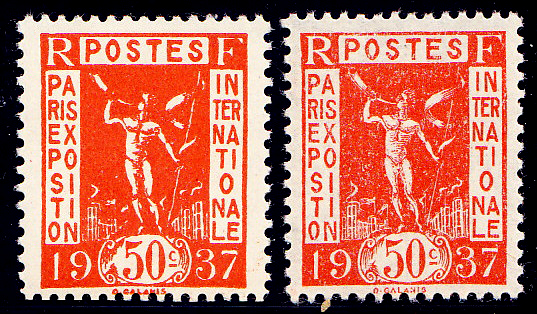
The fake 50c Galanis stamp, forged in 1937, is on the left. Some of the buildings to the right of 'ON' on the fake have disappeared. The horn of the fake is not complete and the lettering is slightly thicker than the original.
The Baron did, and the stamps were traced back to a postal recette auxiliare at Viroflay near Versailles. Two forgers were apprehended and claimed to have made 24,000 stamps which were nearly all retrieved. The forgeries varied from the original in a number of ways: the signature D Galanis became O Galanis; the orange colour was redder than it should have been; the reverse of the stamp was warped as if it had been re-gummed; and finally "le genie n'a pas de sexe".
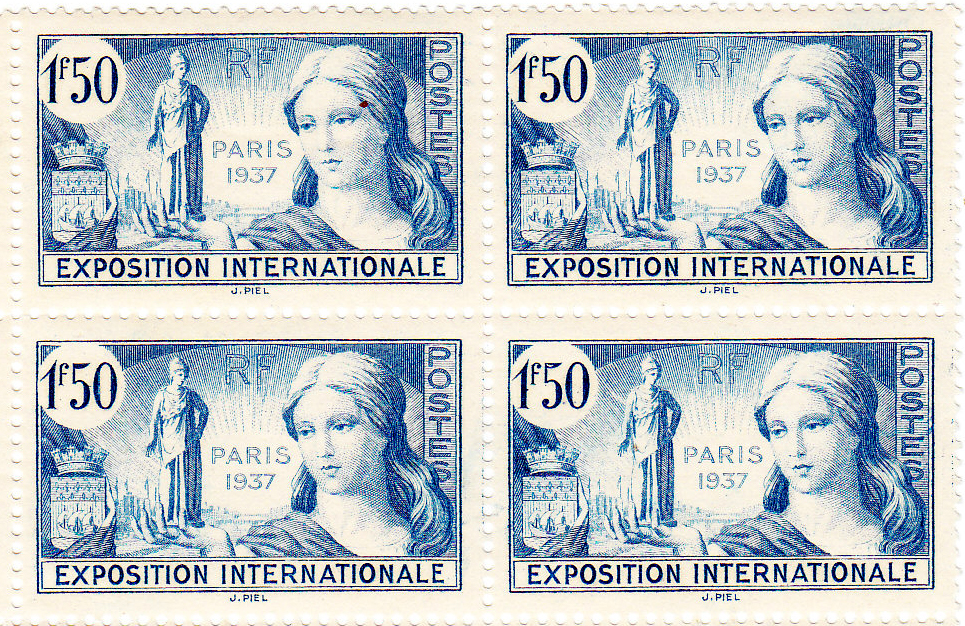
Coins datés for the Jules Piel design issued in 1937
The Galanis stamp debacle was not quite over. In the final days of printing the 50c it was noticed that too much blue had been placed in the colouring and that the red-orange colour had turned to red-carmine. The effected sheets were put to one side to incinerate. However, two or three were squirreled away and sold off. It is now considered officially as a colour variety of the original and listed in the Stanley Gibbons France catalogue as 558a. The Gibbons' price for one of France's rarest stamps is currently £15,000 though, buyer-beware, there are more forgeries than genuine versions of this stamp.
After the turmoil with the designs, execution and distribution of the 1936 publicity stamps for the exhibition, the PTT decided to take no chances with the commemorative issue. The stamp that was meant to coincide with the opening of the exhibition was handed over to Jules Piel.
Piel engraved over 150 stamps for France alone. He was commissioned to engrave threeMariannedefinitives, which is usually regarded as the greatest honour for a French engraver.
For this design he created another Marianne that represented France, holding a statuette of Minerva - goddess of science and industry. On the left is the coat of arms of Paris and in the background some of the exhibition's pavilions. The 1f 50c stamp was issued, as planned on 15 March 1937, the day that the international exhibition was due to open. In total, 30 million were printed and more than 8 million were sold which made it a successful emission. Which is more than can be said about the exhibition which was not to open for another two months.
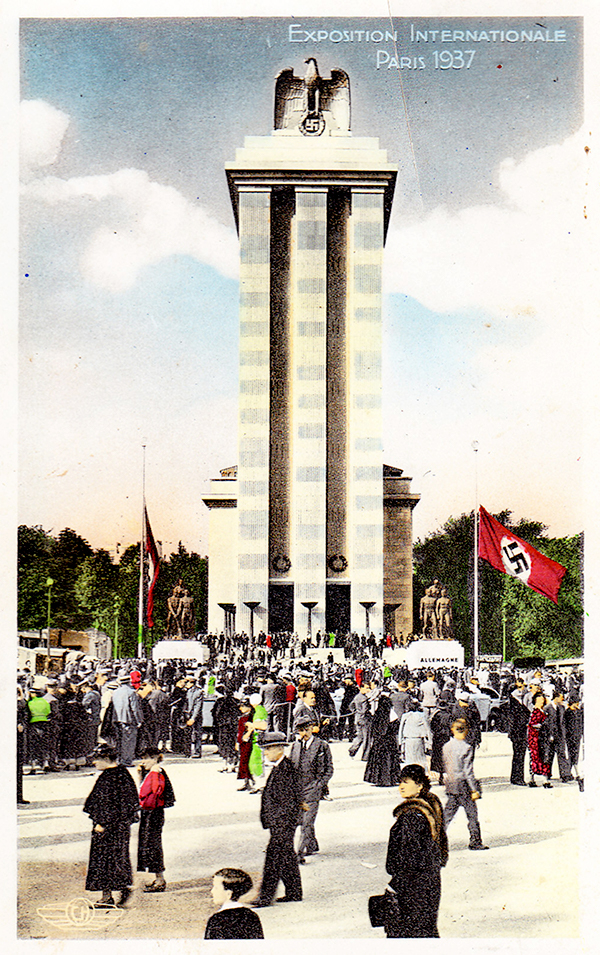
The German pavilion had the Nazi's Imperial Eagle looking down on the Soviet pavilion
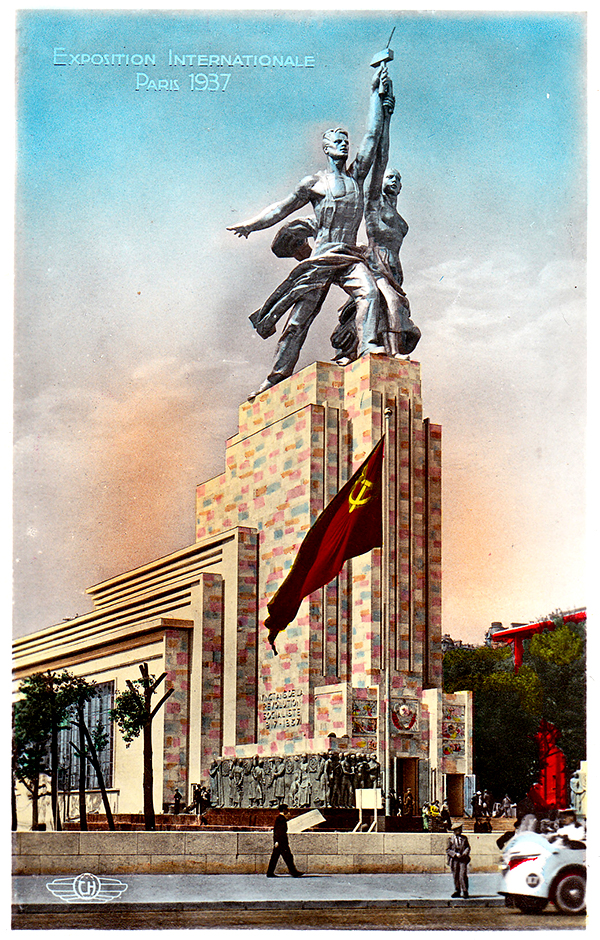
The Soviet Union pavilion had a giant sculpture of a couple holding a hammer and sickle aloft
Continuous strikes throughout the winter of 1936/7 meant that little building work had been done for the exhibition during those months. The running joke at the time was: "Well, at least the Seine and Eiffel Tower are ready." Riots, with seven killed, at the beginning of the year and floods in March meant that the inauguration was delayed until 25 May.
Within the exhibition complex the German and Soviet Union pavilions were placed opposite each other. The Nazis and the communists were fighting each other in Spain at the time so it was surprising to locate their pavilions so close to one another. The Germans avoided France's internal strife by bringing in their own workforce who worked day and night under the direction of the Fuhrer's architect, Albert Speer. The USSR appealed to French communists to work for free, which they did, and they too managed to complete their pavilion before the previewed opening date.
French Colonies
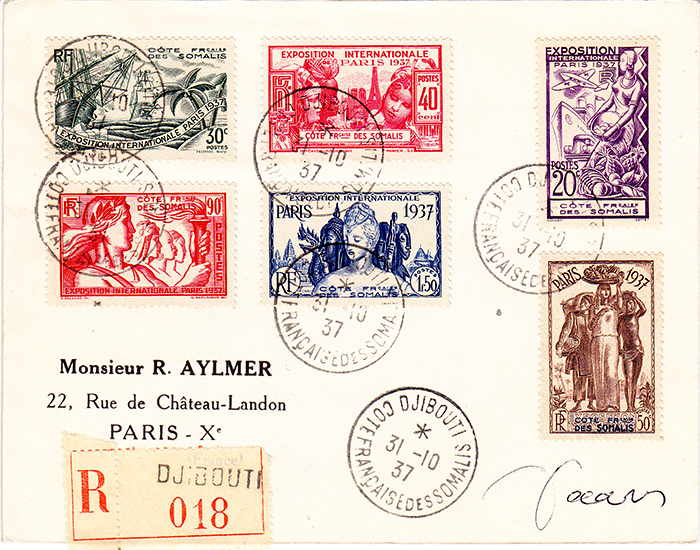
Full set of France Colonies stamps on a franked envelope which has been signed (bottom right) by Albert Decaris the designer of the 50c and 1f50c.
A set of six stamps was created for the 21 French colonies with the same values as the France issue and were released on 15 April 1937. In this series, 19 of the 21 overprinted names of the colonies were executed in a single process for five of the stamps. With the sixth stamp, the 50c, the country's name was overprinted in black over the words 'EXPOSITION INTERNATIONALE'. The remaining two colonies, Indochine and Etablisements Français dans l'Inde, both had their own local currency - ie not francs - so they were not overprinted and were instead printed in one press.
It is interesting to note that there was no overall typographical consistency with the designs for this set. Albert Decaris who created the 50c and 1fr50 has written the number '7' with a bar through it, whereas none of the others represent the year 1937 with a barred 7. And his writing of the word 'POSTES' is in a different typeface from the others which sometimes use a serif font on the equivalent word.
Souvenir sheets were printed by the French Imprimerie Nationale in sheets of 16. The souvenir sheets were released on 29 November 1937 to commemorate the participation of its colonies at the Paris World Exhibition. They were only sold in Paris and not in the colonies, but were nevertheless valid postage. Accordingly, the only way to obtain a genuine cancelled sheet was for someone to privately send a sheet obtained in Paris to the respective colony. Not a common scenario, and yet less likely at the beginning of World War II when, in all the colonies declaring for Free France, only issues overprinted with 'France Libre' were valid stamps for postage.
Algeria, Syria and Lebanon were considered as departments of France and issued their own stamps. Algeria had four stamps featuring the same image of their pavilion at the exhibition. And Syria and Lebanon issued seven stamps with the same picture of their shared Pavillon des Etats du Levant.
Vignettes/Cinderellas
There was a veritable explosion of vignettes (cinderellas) issued for the 1937 Expo. It is difficult to confirm the exact number published as dozens of organisations chose to print them. Louis Granger, in a 1947 article he wrote for the Association Française d'Erinnophilie's (aka Arc-en-Ciel), counted 753 different ones - the most for a single event since the 1900 International Exhibition. In Paris however, many weren't that different, often using the same image within an alternative framing.
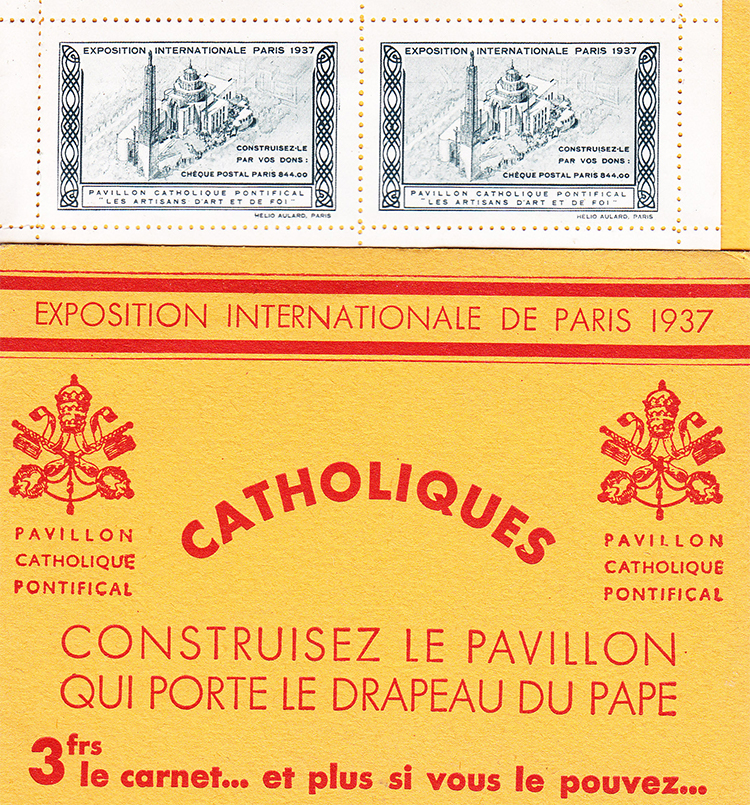
The Catholic Pavilion vignette design was by studio Helio Aulard Paris which specialised in engraved postcards of Catholic saints.
Some were used for fundraising purposes including the one issued by the Catholic Church. These vignettes were sold to help build the Pavillon Catholique Pontifical at the exhibition. The dome of which was constructed to resemble the Pope's crown and a big selling point, advertised on the booklet, was that the papal flag (yellow on the hoist side with the Vatican City coat of arms on the a white background on the right hand side) would make its exhibition debut here.
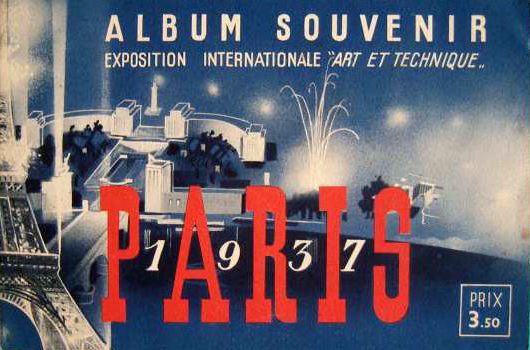
The cover of a booklet containing 10 vignettes
In total, there were 140 pavilions with 52 different countries represented. They all had to be taken down at the close of the exhibition excepting the Catholic pavilion which was allowed to remain open and functioning until finally being taken down in November 1938.
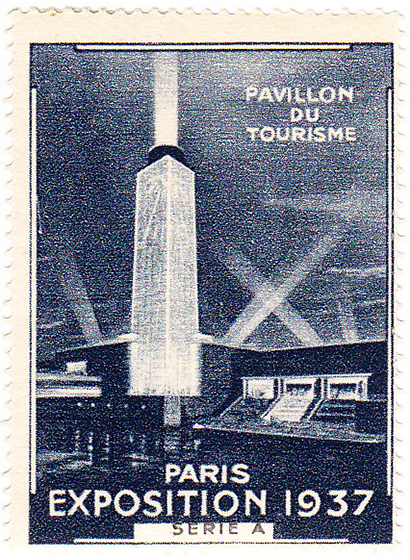
Vignette from the Couté Expo set
The majority of the vignettes were representations of the pavilions themselves. Perhaps one of the most artistic set of designs was distributed by a greengrocer. La Maison Couté, a big épicerie on the Boulevard Raspail in Paris, had the idea of distributing Expo vignettes to clients for every 10 francs they spent in their shop. The customer could stick these onto a Couté Expo souvenir sheet. There were 17 created in a slate-grey colour and they are excellent representations of the art deco style of the time. The shop refused to sell the stamps separately to collectors, only to those who spent money in their shop. They are labelled 'Serie A' implying that a second set was originally planned.
ENFIN
After 185 days of sometimes controversial and ruinous existence, the 1937 Paris Exposition Internationale des Arts et Technique closed on 25 November. 34 million people had passed through its gates, 30% less than the 1900 exposition. The government had spent hundreds of millions of francs more than it had been able to recoup. To date, France has refused to host another.